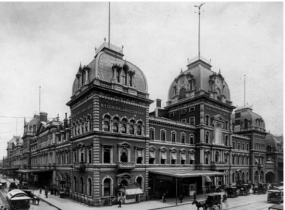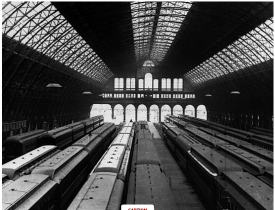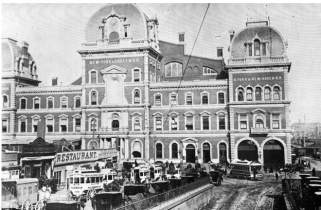


“But there! The bell sounds and we must aboard. This is our train, here on the right. Now we are seated, the bell rings again, and off we go.” [1]This was an account from a passenger boarding a train as recalled in the book, “Homes of the Sound For New York Business Men…”. The Grand Central Depot served over 15 million passengers a year, averaging 48,600 passengers, day in and day out.[2] The building of the Grand Central Depot in 1871 was truly the start of something new. It is important to note that the opening of the Grand Central Terminal caused a majority of the people to forget the idea of the Grand Central Depot. As I was conducting research on the Grand Central Depot, I noticed much of the information of the Grand Central Terminal was intermixed with the information about the Grand Central Depot. My goal is to pull out hidden sources and personal accounts about the Grand Central Depot and to show the impact it had not only on New York City, but also our nation as a whole.
Towards the end of the Civil War, the railroads grew and had a great impact on the nation. Railroads were one of the reasons society was able to shift from an agricultural society to an industrial society. Railroads connected cities with other cities and farms. Railroads helped greatly with time and distance.[3] The cost of transport went down and it was much easier and faster to transport not only people, but goods as well.
Cornelius Vanderbilt was born in 1794 in Staten Island, NY.[4] He was known as one of New York’s wealthiest people during the 19th century. He built steamships and oversaw the operation of ferry lines connecting the different boroughs of New York. By the 1860s, he had changed his focus from ferries and boats to railroads. He was interested in building railroads to Manhattan Island. One of New York’s first railroad companies was built in 1832 and was called the NY and Harlem Railroad.[5] This railroad company employed the idea of using horse carriages and placing them on railroad tracks between Manhattan and Harlem.[6] There were other railroad companies that started up following that such as the New York, New Haven, and Hartford railroad and the NY Central Railroad to name a few. Vanderbilt really sought to take control of all of them and merge them under one company. Vanderbilt did exactly that, he took the NY central railroad, which was parallel to the Erie Canal and merged it with Hudson River Railroad to form the NY Central and Hudson River Railroad.[7] The Hudson River Railroad company linked Poughkeepsie to New York City. In addition, he took the Harlem River Road and tried to integrate it with the NY Central and Hudson River Railroad. At that point, he controlled all of the direct rail stations on Manhattan Island and that soon came to be known as the parent company for Grand Central Depot.
Vanderbilt desired to create a new terminal for the people where the trains would all be under one roof. He decided to build a new terminal, known as the Grand Central Depot, on the east side of Manhattan, at the Harlem’s rail yard that stretched from 42nd street to 56th street on Lexington and Madison Ave. [8]He hired an architect, Henry Snook, and an engineer, Isaac Buckhout, to design the Grand Central Depot.[9] It was about 100 feet high, 200 feet wide and more than 600 feet long with the roof made of iron and glass. It held the three rail lines: the NY Central and Hudson River Railroad, the NY, New Haven, and New Hartford Railroad, and the Harlem Railroad. It soon turned to be the largest enclosed space in the country at the time and costed about $6.4 million by the time it was completed in 1871. At that time, about 170 trains were going in and out of the station daily. The book, “Homes of the Sound For New York Business Men…” was a guidebook written for business men who thought about purchasing a suburban home in the area between New York and New Haven. [10]The narrator of the book “Homes of the Sound For New York Business Men…”, talks about the Grand Central Depot upon entering it:
“We enter this mammoth structure from Forty-second street, and view with untiring delight its grand arches, its magnificent scope, and its elaborate yet substantial finish. All that railroad experience and architectural skill could suggest have been here to meet the convenience of the traveler, and give to New York City the most complete railway station in America, or it may be, in the world. The waiting rooms and ticket offices of the Company we shall find to be of the most commodious and convenient character.”[11]
Grand Central Depot was this enormous building that took up almost 21 acres of land and it was very different from other buildings due to its appearance and size. Many people just came to the Grand Central Depot to visit and observe how the Grand Central looked and functioned because it was something they hadn’t seen before.
Although the Grand Central Depot helped transform American society at large, people started to notice the flaws of it which led to its downfall and the building of the Grand Central Terminal. The Grand Central Depot was soon found to be too small; as the population grew in NYC, more people were prone to using the railroad station. By the 1890s, about 500 trains were using the Grand Central Depot.[12] The station was at the end of the railroad track, so any incoming railroads would have to be reattached to the train cars heading in the opposite direction. It made it hard for trains to go either east or west because of it.[13] The railroad station had poor ventilation. Many passengers complained about suffering from inhalation of steam and smoke while waiting for the train. In addition, a portion of the Grand Central Depot was given the name “The Death Alley” because a lot of pedestrians were killed by the trains.[14] It was very dangerous to cross the streets because of the way the railroads were built.
One article written and published in November of 1871 by The New York Times, on Vanderbilt’s behalf, attempted to put people’s concerns to rest by explaining that Vanderbilt’s initial intentions were to build a fence around the tracks and to build bridges wherever the tracks crossed with places where people could walk or carriages could go through.[15] Unfortunately, the company did not get permission from the city to do so. In addition, another concern was that during the night, people living near the railroad tracks often heard whistling and shrieking type of sounds. The NY Times stated that employees of the railroad company would receive instructions to trying to keep the noise level to a minimum during evening hours, but people weren’t satisfied. It was believed that people would feel satisfied if the railroad tracks were pushed deeper in the ground. One resident wrote a letter to the editor in response of this article and mentioned that:
“There is no single thing on New-York Island so dangerous to the community and prejudicial to its interests as this Valley of the Shadow of Death, which cuts the City in two its entire length, and stretches, unpaved, ungraded, and is given over to the hundreds of locomotives that continually dash up and down…”[16]
The resident explains the idea that these railroads were essentially taking over in a bad way. Furthermore, the resident continues to say that not only were the railroad tracks extremely dangerous, they also caused the residential property value to go down and the pollution and sounds of the trains were a nuisance to the people.
In January of 1902, there was a crash in the Park Avenue tracks that ended up killing about 15 passengers and injured about a dozen people. This crash was caused by lack of visibility due to the steam of the trains. In 1903, the use of steam locomotives was banned in the south of the Harlem River. The city notified the people that this new ban would take effect in three years, in 1906. City officials believed that three years was ample time to fix up the station. [17] Furthermore, this ban meant that the rail lines would have to be converted to electric power, but the way the Grand Central Depot was built, the entire station would have to be torn down in order for that to happen. These were just a few incidents that led people to have negative attitudes towards the use of railroads. Many people wanted to revert back to using the horse carriages, but the impact of these issues were too big that the city had no choice but to build a new station which today we know as the Grand Central Terminal.
Overall, the railroad industry helped expedite the industrial revolution by rapidly transporting goods and it allowed for people to have a faster mode of transportation. Although the Erie Canal was known for connecting the east with the west, the railroad industry added to that impact. It not only allowed transportation within the city, but it also allowed for transportation from city to city and to farms. In addition, the railroad system allowed the city to expand northwards and it provided employment for about 2,000 men.[18] It is evident that society has been able to progress with the help of innovations and technology, which in turn supports our economy.
Images (from left to right):
[1]“Grand Central Through the Years”, Photograph, 1871, http://www.pbs.org/wgbh/americanexperience/features/photo-gallery/grandcentral-gallery/ (Accessed November 13, 2016)
[2]“Grand Central Through the Years”, Photograph, 1871, http://www.pbs.org/wgbh/americanexperience/features/photo-gallery/grandcentral-gallery/ (Accessed November 13, 2016)
[3] Levine, “Our Hospital’s Neighbor: A Friend in the Grand Central Depot,” photograph, 1880, https://www.hss.edu/playbook/our-hospitals-neighbor-a-friend-in-the-grand-central-depot/#.WCjaZ5grJhE (Accessed November 13, 2016)
Text:
[1] Homes on the Sound for New York Business Men: A Description of the Region Contiguous to the Shore of Long Island Sound, Between New York and New Haven (New York: G. L. Catlin, 1875), 7.
[2] Kurt C. Schlichting, Grand Central’s Engineer: William J. Wilgus and the Planning of Modern Manhattan (Baltimore, John Hopkins University, 2012), 44.
[3] Schlichting, 6.
[4] “Cornelius Vanderbilt”
http://www.history.com/topics/cornelius-vanderbilt (Accessed November 13, 2016).
[5] Schlichting, 25.
[6] “Before There Was a “Grand” in Central
http://www.nytimes.com/2013/03/03/realestate/before-there-was-a-grand-in-central.html (Accessed November 13, 2016).
[7] Schlichting, 25.
[8] Jeff L. Brown, “The Heart of New York: Grand Central Terminal,” Civil Engineering 833 (2013): 2.
[9] Brown, 38.
[10] “Before There Was a “Grand” in Central
http://www.nytimes.com/2013/03/03/realestate/before-there-was-a-grand-in-central.html (Accessed November 13, 2016).
[11] Homes on the Sound for New York Business Men: A Description of the Region Contiguous to the Shore of Long Island Sound, Between New York and New Haven (New York: G. L. Catlin, 1875), 7.
[12] “Before There Was a “Grand” in Central
http://www.nytimes.com/2013/03/03/realestate/before-there-was-a-grand-in-central.html (Accessed November 13, 2016).
[13] Jeff L. Brown, “The Heart of New York: Grand Central Terminal,” Civil Engineering 833 (2013): 39.
[14] Schlichting, 25.
[15] “The Grand Central Depot,” New York Times, November 18, 1871, 1.
[16] “The Grand Central Depot,” New York Times, November 18, 1871, 4.
[17] Jeff L. Brown, “The Heart of New York: Grand Central Terminal,” Civil Engineering 833 (2013): 39.
[18] Homes on the Sound for New York Business Men: A Description of the Region Contiguous to the Shore of Long Island Sound, Between New York and New Haven (New York: G. L. Catlin, 1875), 8.
Empire State Express, it went all the way from NYC to Buffalo in 7 hours
Hello,
I have an question.
My great grandfather arrived by ship in New York on the first of april in 1892.
He was an immigrrant from Holland and he took a train to Buffalo Chicago.
Was that train departing from the Grand Central Depot????
What was the name of the railroad company????